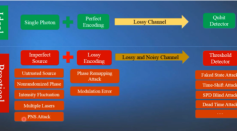Tags: Quantum Computing
New Open-Source Software Checks Quantum Annealers, Including Noise and Qubits
It’s a Kind of Magic! Researchers Make Versatile Quantum Devices Out of Graphene
Researchers Fabricate Material That Has Both Quantum Hall Effect and Superconductivity
Quantum Brain: Scientists Discover How to Revolutionize Computing
Quantum Entanglement of Electrons Achieved Through Heat
ESA’s Φ-Week 2020 Highlights Digital Twin Earth, AI, and Quantum Computing

4 Examples of Origami-Inspired Innovations in Science

New Quantum Key Distribution Protocol Maintains Security Over Long Distances
Yale Creates Error-Correcting Cat for Quantum Computers

Quantum Negativity Could Improve Metrology Precision

US Reveals Potentially Impenetrable Quantum Internet
Quantum Computing: Trying to Scratch the Surface
Quantum Computer Time Reversal: Can It Happen?
Quantum Cryptography Reaches A New Milestone In Quantum Secure Direct Communication
An Engineer At The University Of Texas at Dallas Designs A Computer System Made Solely Of Carbon
Researchers from National University of Singapore and Caltech Discover Quantum States Fingerprint to Prevent Quantum Computing Error
Diamond Can Generate Dynamic Unpolarized Single-Photon: New Important Stage For Quantum Computing
2D Material Successfully Conducted Electricity At Nearly The Speed Of Light: Paves Future Of Quantum Computers
3D Quantum Liquid Crystals: New State Of Matter Discovered To Make Future Ultrafast Quantum Computers Possible
IBM Adds New API To Quantum Computing Cloud Services: Offered Access To 50-Qubit Quantum Pc?
Most Popular

The Strongest Tornadoes Ever Recorded: Scientific Breakdown of Extreme Tornado Events

How Space Affects the Human Body: Key Health Challenges Impacting the Astronauts

Can Scientists Predict Earthquakes? The Latest Advances in Seismic Forecasting Explained

Photosynthesis Made Easy: Light Reactions, Calvin Cycle, and Everyday Examples





